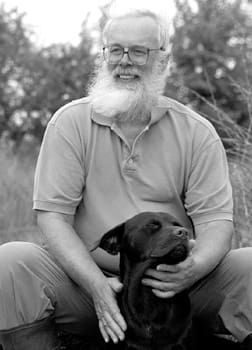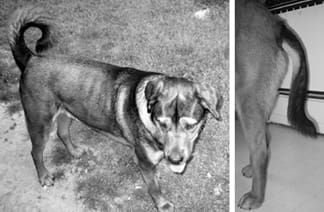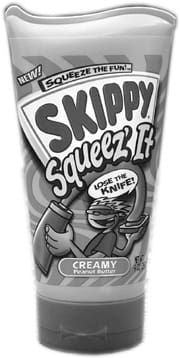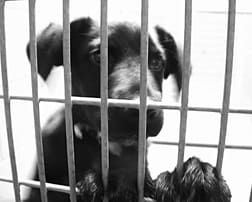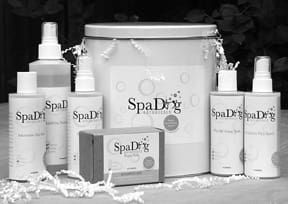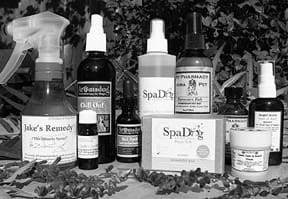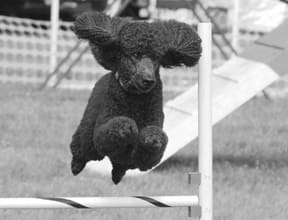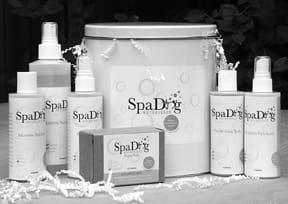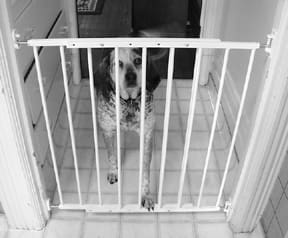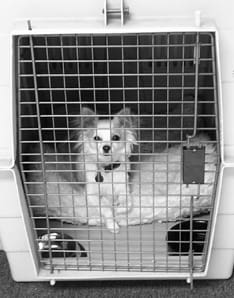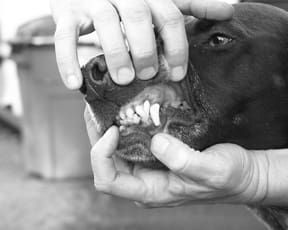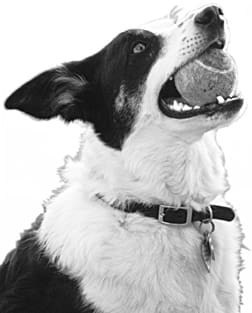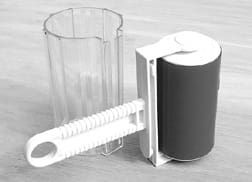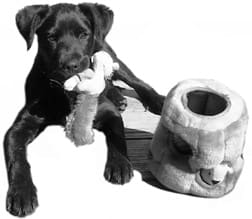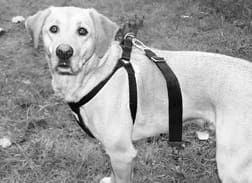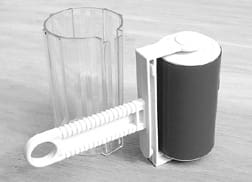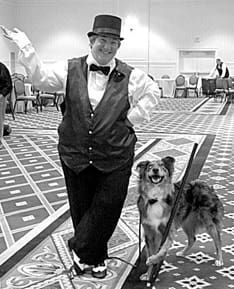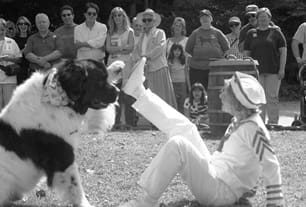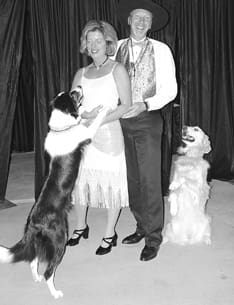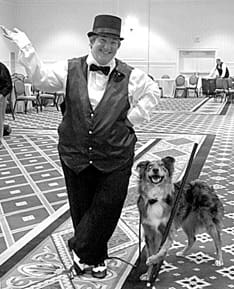The dog respiratory system or any respiratory system functions rather miraculously. Vital for life, critical for the health of the whole body, it’s one of the major ways the dog’s body unites his external environment with his inner milieu. As a primary site of contact with the outer world, the lungs are susceptible to diseases that can be caused by any airborne germ, irritant, or toxin that happens to be floating around.
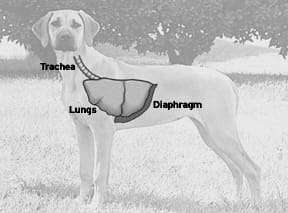
Holistic practitioners understand that respiratory symptoms can be an indication of disease or a sign of healing – the key is differentiating between the two. Some alternative and complementary medicines have proven to be beneficial for many respiratory conditions, especially mild diseases and those that have become chronic.
Architecture of respiration
In addition to the nose, larynx, and pharynx (which were discussed in detail in “Know the Nose,” WDJ November 2004), the respiratory system consists of the trachea, bronchi, bronchioles, alveoli, and the parenchymal tissue of the lungs.
From the trachea to the alveoli, a map of the lungs would look like a tree – each branch dividing into many, ever-smaller branches until the end point of several million alveoli is reached. Each alveoli is a round receptacle where gas exchange occurs via contact of the inspired air with blood across an extremely thin layer of tissue surrounding the alveolar capillaries.
The respiratory system performs several functions. Its most important utility is to act as a gas exchange: it delivers oxygen for distribution to the body, and removes carbon dioxide produced by living cells. In addition, the respiratory system filters out particulate matter, maintains the body’s acid-base balance, acts as a blood reservoir, protects its own delicate airways by warming and humidifying inhaled air, and is active in producing substances that initiate the immune system response. The upper airways also provide for the sense of smell and play a role in temperature regulation in panting animals.
Normal respiratory rates vary, depend-ing on the size of the dog, from 10 to 30 breaths per minute; larger dogs have slower rates. Panting – a rapid, open-mouthed, and shallow breathing pattern – is a normal canine reaction, brought on by exercise and/or the need to cool the body.
In the healthy animal, particulate matter and the small amounts of mucus that are normally generated are removed by cilia (minute hairs that line the trachea and bronchi) and coughed up or swallowed. Many microorganisms live in the normally healthy respiratory system; their pathogenicity is held in check by local and systematic immune factors.
According to Western medical practitioners, disease of the respiratory system occurs when irritants greatly increase the amount of mucus produced (in excess of what the animal can expel naturally), when the immune system allows for attachment and growth of pathogenic microorganisms, or when local cells are stimulated to become malignant (from excess exposure to carcinogenic toxins, for example).
Alternative view
Traditional healers have long respected the healing power of correct breathing, and their ways of thinking about the respiratory system reflect this understanding.
For many cultures the breath is equivalent to the Qi (pronounced “chee” and often spelled chi) or Prana (vital force) that circulates throughout the body and gives it life and vitality. From this view, respiratory disease may be considered the result of a weakened protective Qi – from a deficiency of Lung Qi production or dissemination.
In most Eastern cultures (and some other cultures) considerable attention is paid to helping people stay healthy by teaching them proper breathing methods – through various forms of meditation, postures (yoga asanas), and active or passive exercises meant to enhance proper breathing.
In Traditional Chinese Medicine the lungs are thought to regulate the Qi of the entire body; a disharmony of the lungs can produce deficient Qi or stagnant Qi anywhere in the body.
The Chinese herbal mixture “Jade Screen” – which includes astragalus (Astragalus membranaceus) – and acupressure points are often used by traditional Chinese medical practitioners to strengthen both Lung and protective Qi. These practitioners also credit the lungs with helping to move moisture through the body. Disharmonies of the lungs’ water-moving function, they say, can result in urinary dysfunction, edema (especially in the upper body), or problems with perspiration. A dog with robust lung health will have a bright, shiny coat and will be resistant to developing colds, persistent coughs, and other aggravating illnesses.
Signs of disease
Any kind of practitioner would recognize coughing as a first sign of respiratory dis-ease. A sudden onset of coughing may be a dramatic indicator of serious disease – pneumonia, secondary symptoms of other viral diseases such as distemper, or lung tumors – or not-so-serious disease, such as common colds or kennel cough.
There are also more subtle signs to watch for, and since some of these signs may be related to either heart or lung problems, it is important to differentiate between the two. Exercise intolerance is the most prominent of these signs. A dog will demonstrate this by lagging back during her daily walks; wheezing, gasping, and straining for air when she is forced to exercise, when she climbs a flight of stairs, or jumps up on your bed; and she may tend to sit in an elbows-out posture. Exercise intolerance and the accompanying signs listed above are the classic symptoms of heart disease, and whenever they are seen, it is time for a visit to the veterinarian.
The same symptoms as those seen with heart disease, however, may also be a sign of aging. Some experts believe that the respiratory system declines in efficiency by up to 50 percent over a lifetime. Bronchial passages constrict, fibrous tissue in lungs increases, and the functional capacity of the alveoli is reduced. In addition, many dogs, over the years, have been exposed to lung damage caused by inhaled allergens, foreign bodies, and microorganisms – all of which can decrease functional lung capacity.
Your dog should visit his vet at least once a year for an annual physical – perhaps twice a year after he’s reached about seven years of age. Use a veterinarian who takes the time to put a stethoscope to the dog’s heart and chest to listen for abnormal sounds. If there is some question about the functional capacity of your dog’s heart or lungs, further testing such as radiographs or an EKG may be indicated.
My own feeling is that the annual physical is absolutely necessary, to monitor how the dog is doing on a yearly basis. Please note that an annual vaccine is absolutely unnecessary, although this is the reason many vets give for seeing your dog every year. In my opinion, it is time for those of us in the veterinary profession to concentrate on the annual physical exam rather than on selling vaccines.
Kennel cough and colds
The two most common afflictions of the respiratory system are the “common cold” and kennel cough. Both of these ailments are usually instigated by any of a number of viruses, often followed by secondary bacterial invasion. The severity of the symptoms varies widely, but in most “colds” they are mild and include wheezing, coughing, reluctance to move, and perhaps a mild fever.
Kennel cough (a.k.a. infectious tracheobronchitis), on the other hand, can produce symptoms that appear extreme, with a dry, hacking cough accompanied by frequent, intense gagging. I’ve had caretakers rush their kennel-coughing dog in to see me, thinking he has a bone caught in his throat. Despite its appearance, a typical case of kennel cough is not life-threatening, and it tends to run its course in a few days to a week or so. But it is a disease that is frustrating for pet and caretaker alike.
Kennel cough results from inflammation of the upper airways. The instigating pathogen may be any number of irritants, viruses, or other microorganisms, or the bacteria Bordetella bronchiseptica may act as a primary pathogen. The prominent clinical sign is paroxysms of a harsh, dry cough, which may be followed by retching and gagging. The cough is easily induced by gentle pressure applied to the larynx or trachea.
Kennel cough should be expected whenever the characteristic cough suddenly develops 5 to 10 days after exposure to other dogs – especially to dogs from a kennel (especially a shelter) environment. Usually the symptoms diminish during the first five days, but the disease may persist for up to 10-20 days. Kennel cough is almost always more annoying (to dog and her caretaker) than it is a serious event.
Other diseases of the respiratory system
Pneumonia is inflammation of the lungs with consolidation (hardening) of the tissues, and this inflammation can be from any number of sources – viral, bacterial, fungal, trauma-induced, or as the consequence of an allergic reaction. Oftentimes the initial stimulus for inflammation comes from airborne toxins – cigarette smoke, city smog, fumes from household cleansers, and outgassing from numerous sources such plastic food dishes or the formaldehyde found in household insulation, new carpets, and furniture.
Pneumonia is not a common malady in dogs, and when it occurs, the symptoms may vary from mild to extreme; in severe cases the disease can be life-threatening. If your dog has extreme difficulty breathing, or if he has stopped eating and is very reluctant to move, it’s time to see the vet. Antibiotics and supplemental oxygen can be lifesaving at this stage.
Likewise, neither asthma nor emphy-sema are common problems in dogs, although they do occasionally occur. Asthma is a condition that causes recurrent bouts of wheezing and respiratory distress due to constriction of the bronchi, and is often allergy-induced. Emphysema is an abnormal accumulation of air in the spaces between the alveoli of the lungs. Both conditions can be difficult to diagnose correctly, often requiring radiographs to determine the extent of damage.
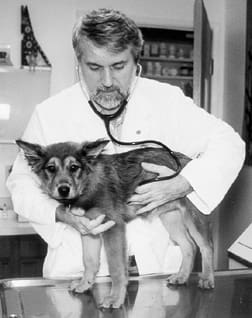
Any dog who demonstrates periodic bouts of respiratory distress or who has had a chronic problem with breathing should be taken to a veterinary hospital for further evaluation. Holistic veterinarians (including me) have had excellent success treating asthma using acupuncture, coupled with immune-system boosters and other herbs to aid breathing.
Trauma that causes tissue damage and/or bleeding into the lungs can also be a cause of respiratory distress. The typical lung trauma case goes something like this: The dog arrives at the emergency clinic in respiratory distress. The owner reports that the dog had been out running loose for a while and he returned like this – a sudden onset. These dogs have often been hit by a car, and the major damage has been internal, to the lungs or diaphragm. Again, whenever your dog is in extreme respiratory distress, it is time to visit your vet.
Respiratory involvement can come secondarily, from other sources in the body, such as an extension of gingivitis from the mouth, diabetes (which lowers resistance to disease), and other infections such as distemper, parainfluenza, or adenovirus. The most common source of secondary respiratory problems, however, comes from the heart.
Cardiac insufficiency, whatever the cause, can cause a decrease in respiratory efficiency, and the clinical signs of coughing, wheezing, and exercise intolerance. Heart conditions, including heartworm infection, need to be differentiated from primary lung involvement, and your vet’s stethoscope is the first step here, perhaps followed up with X-rays and other tests.
Lung tumors can be either primary (originating in the lung tissues) or secondary (metastasizing from other parts of the body and lodging in the lung tissues). Both of these can create nasty tumors that are difficult to treat, whatever method you choose to use. My experience with these is that if there is anything that can help them, it will be classical homeopathic remedies. Since it is thought that many lung tumors are instigated by contact with airborne toxins, it’s important that we do all we can to eliminate them from our own and our dog’s environment.
Care of the respiratory system
Oxygen is the most lung-friendly nutrient available for man or beast. Make sure your dog’s lungs (and outlying tissues) are adequately supplied with oxygen, by taking – at minimum – a daily 20- to 30-minute walk at an easy trot pace (the pace where you can carry on a normal conversation with your dog so passersby will think you are crazy).
I also think that a daily anaerobic romp – sprinting to retrieve a ball, for example – helps to expand the functional capacity of the lungs. Be sure to have your dog’s heart and lungs evaluated by a vet before you begin a new exercise program.
The second most important thing to do for the health of your dog’s lungs is to eliminate all the toxins you possibly can. Many of the commonly found air pollutants cause irritation to the airways of the lungs and this irritation stimulates mucus production. The mucus in turn stimulates coughing. Other irritants cause the smooth muscles to constrict around the alveoli, eventually causing asthma or emphysema. Finally, many of the air pollutants are known carcinogens; persistent contact with them is a disaster waiting to happen.
While exploring ways to eliminate air pollutants is beyond the scope of this article, it is definitely a topic for you and your family to explore. As a first step, though, make sure your (and your dog’s) house and living environment have adequate ventilation.
The next (and final) step to assuring respiratory health is to energize the immune system. Proper diet, limited stress, along with vitamins A, C, and E and other antioxidants such as the culinary herbs and Coenzyme Q10 are all beneficial to the immune system. Herbs that are directly beneficial for the immune system include echinacea and astragalus. Check with your holistic vet for correct dosages of these supplements and herbs.
Alternative medicines for respiratory conditions
There are two important things to remember about alternative medicines and the respiratory system:
1) In Western medicine, it is often impossible to treat a condition without knowing the cause; in most alternative medicines (Chinese medicine and homeopathy in particular), the treatment is always for the condition itself, regardless of the cause.
2) Holistic treatments begin with the realization that most respiratory infections are really signs of the body’s healthy effort to expel toxicity – via mucus from the nose, sneezing, puffy red eyes with mucus-like secretions, and coughing and phlegm.
While the Western medicine man will focus intensely on diagnostic procedures to try to determine a specific diagnosis, the alternative practitioner observes symptoms as they occur and treats accordingly. And, whereas the Western practitioner’s treatments are often aimed toward palliation of symptoms (easing the cough, for example), the alternative practitioner understands that respiratory symptoms may be a good sign that the body is responding in a healing manner.
• Herbs. There are several herbs that may be beneficial for treating respiratory conditions. The following have been used to treat the symptoms seen with respiratory disease. Herbal dosages and method of delivery vary with the needs of the animal; check with your herbal practitioner.
Herbs that enhance the immune system include echinacea (Echinacea spp.), astrag-alus (Astragalus membranaceus), Siberian ginseng (Eleutherococcus senticosus).
Herbs with antibiotic activity (for lung infections) include Oregon grape root (Mahonia aquifolium), goldenseal (Hydrastis canadensis), and echinacea. Herbs for bronchial congestion include oregano (Origanum vulgare), bloodroot (Sanguinaria canadensis), thyme (Thymus vulgaris), and ginger (Zingiber officinale).
Herbs for acute bronchitis include marshmallow (Althaea officinalis), cinnamon (Cinnamonum camphora), turmeric (Curcuma domestica), echinacea, fennel (Foeniculum vulgare), chamomile (Matricaria chamomilla), and peppermint (Mentha piperita).
To ease coughing, try the following herbs: marshmallow, pleurisy root (Asclepias tuberose), oats (Avena sativa), calendula (Calendula officinalis), licorice (Glycyrrhiza glabra), peppermint, elder (Sambuscus nigra), thyme, coltsfoot (Tussilago farfara), and mullein (Verbascum thapsus).
My own preference has been to use licorice root to ease the cough (and for its adaptogenic qualities), echinacea for its immune-stimulating properties, and Oregon grape root for its infection-fighting abilities. I then consider adding other herbs as the symptoms indicate.
• Massage may prove beneficial in preventing and treating respiratory diseases. Dogs can become very anxious whenever their breathing is difficult or restricted, and anxiety tends to constrict breathing. A whole-body massage may be relaxing enough to help produce more normal breathing patterns.
• Acupuncture is one of the best ways to treat respiratory disease, and it has been shown to be especially helpful for treating asthmatic patients. Acupuncture points along the Lung and Large Intestine Meridian are the primary points to use, with additional points possibly located along the Spleen, Kidney, and/or other Meridians, depending on the symptoms.
When treating a wet cough, in addition to herbs for bronchial conditions and coughing (see the herbal section, above), your veterinary acupuncturist will consider removing “dampness” from the lungs by needling the Spleen-6 and Kidney-3 acupressure points, while also enhancing the immune system by stimulating Large Intestine-11. You can use acupressure on the same spots (ask your acupuncturist to show you their locations). Use moderate pressure over the spots for several minutes, or until your dog seems to be uncomfortable with the pressure. Don’t continue past that point!
The Lung and Large Intestine Meridians (the paired Meridians that are associated with lungs and respiratory function) run on either side of the dog’s forearm; to stimulate points along this meridian, massage up and down the forearm beginning at the shoulders and extending down to the dew claw and first digit of the paws.
Each Organ system, in the Traditional Chinese Medicine way of thinking, has an emotional component attached to it. Sadness and grief are related to the lungs, and an excess of sadness or grief may weaken Lung Qi.
• Flower essences can be very helpful for treating emotional disturbances, and if your dog has problems with lung disease, especially if the problems are persistent or recurring, think about the possibility of sadness or grief as contributing factors. Consider flower essences whenever there is the potential for your dog to be sad or grieving, such as when a human member of the family leaves through divorce, or a four-footed companion who has lived with the family passes on.
When your dog seems to be grieving, try the flower essence remedies Star of Bethlehem, pine, and/or wild rose. If she seems to be extremely gloomy and utterly sad, try mustard or wild rose. If the sadness is the result of homesickness (from a recent move, for example) try honeysuckle and clematis. Walnut is an excellent remedy anytime there has been a transition in the family – a family member suddenly leaving, for example, or after moving from one house to another.
Flower essences can be used singly, or up to five remedies can be combined and used together. Remedies are typically diluted. Use several drops per ounce of spring water, and a few drops of this dilution can then be given orally, a few drops added to the dog’s water, or the diluted solution can be placed in a misting bottle and spritzed over the dog’s body. (See “Flower Power,” March 1999, for more information about flower essence remedies.)
• Homeopathic remedies. There are literally dozens of homeopathic remedies that have been shown to be helpful for treating all sorts of respiratory illnesses, again depending on the symptoms observed. Examples include:
• For a dry, spasmodic cough: Belladonna, Bryonia, Stannum
• For coughing and difficult breathing: Arsenicum alb., Kali carb., Lycopodium, Phosphorous
• For asthmatic breathing: Apis, Sulphur, Lobelia inflata
• For cases of “heart cough”: Naja, Prunus v., Spongia
For more information about homeopathy, see “Tiny Doses, Huge Effects,” WDJ June 2000.
Also With This Article
Click here to view “The Many Causes of Kennel Cough”
Click here to view “Kennel Cough Treatment and Prevention”
Click here to view “Determining the Cause of Your Dog’s Panting”
-Dr. Randy Kidd earned his DVM degree from Ohio State University and his PhD in Pathology/Clinical Pathology from Kansas State University. A past president of the American Holistic Veterinary Medical Association, he’s author of Dr. Kidd’s Guide to Herbal Dog Care and Dr. Kidd’s Guide to Herbal Cat Care.


